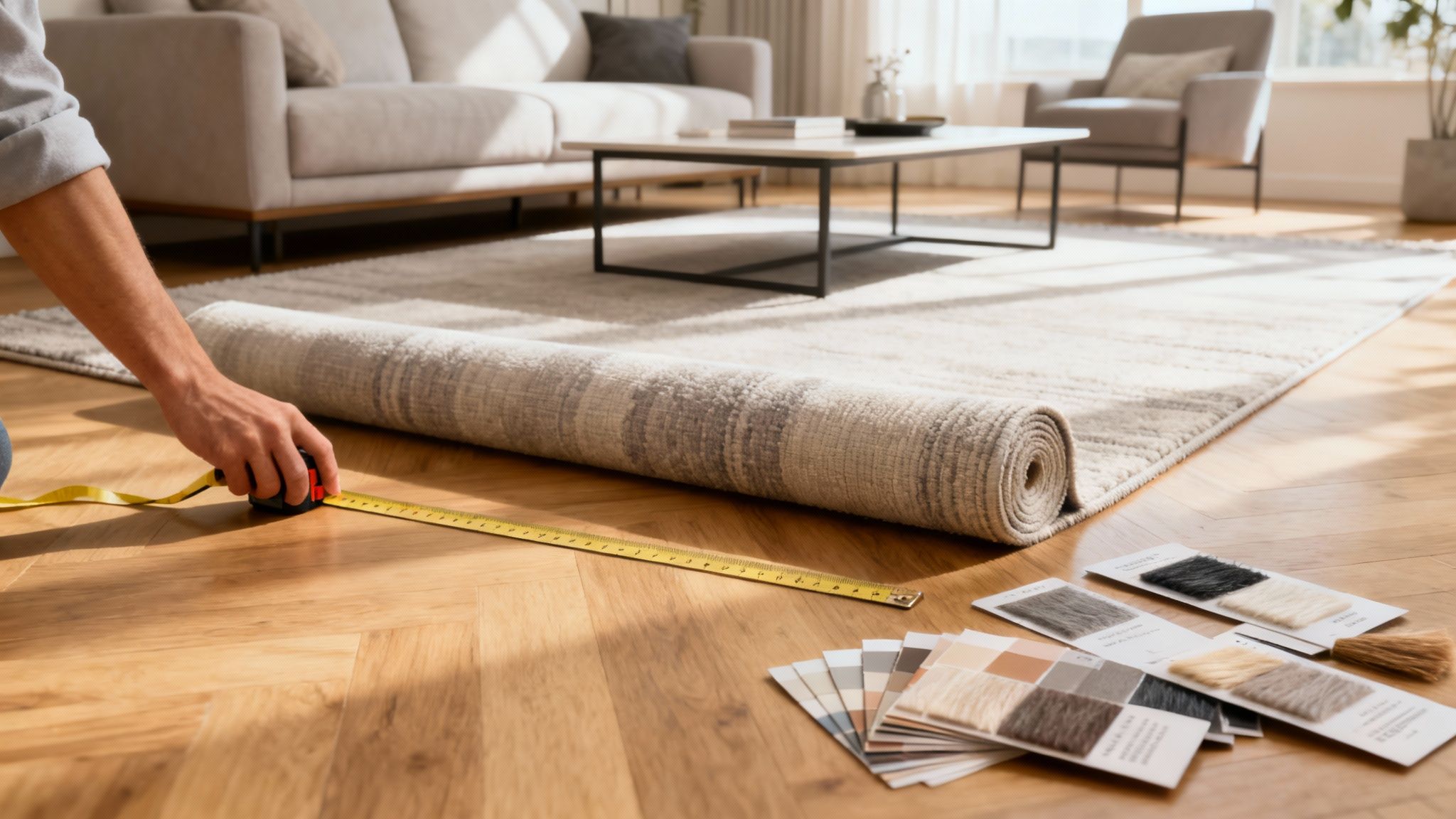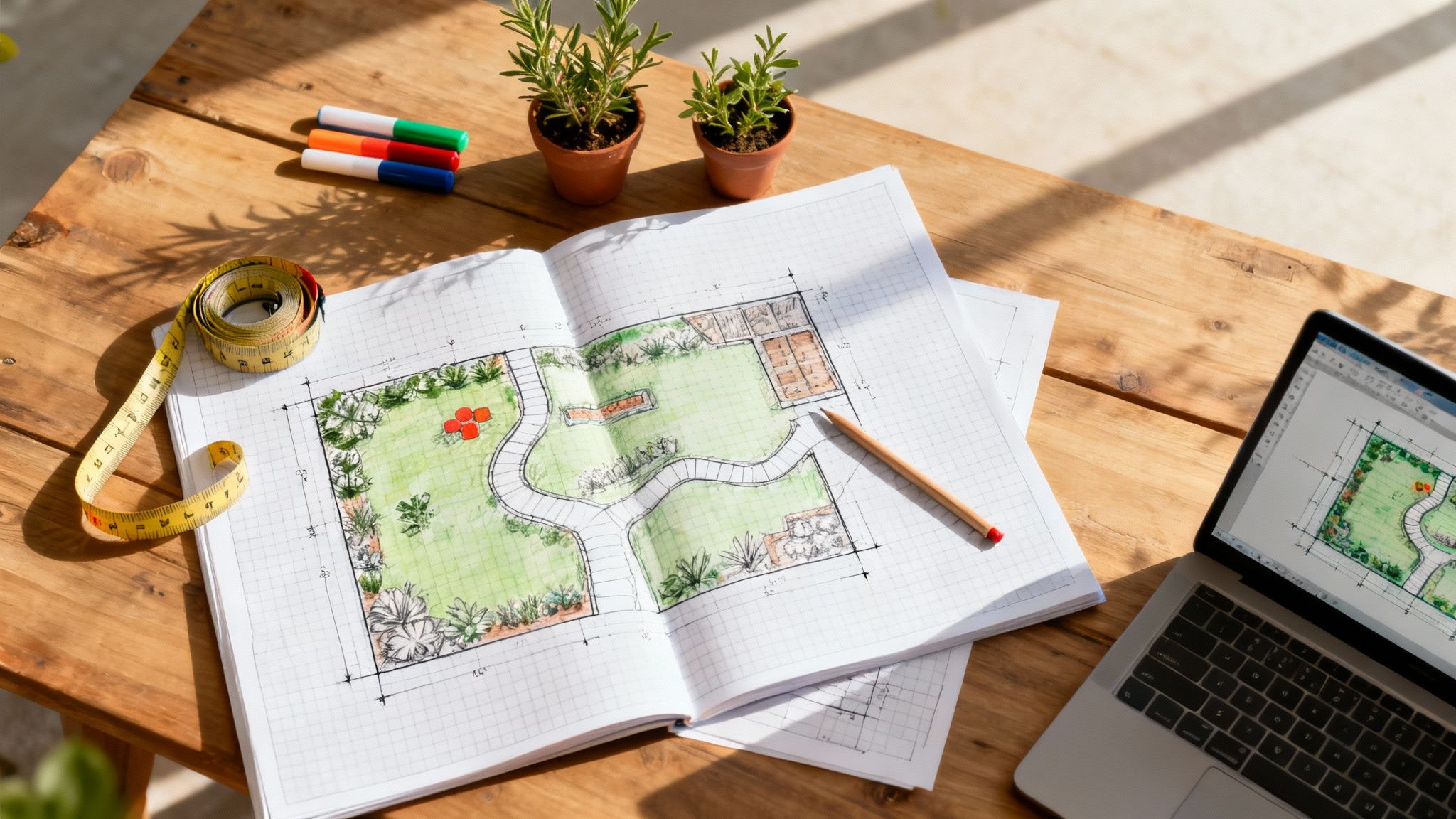When you’re thinking about how to choose a rug for a living room, it really boils down to three things: getting the size and placement spot on, picking a material that can handle your day-to-day life, and finding a colour or pattern that pulls everything together. Get these right, and your rug will be the anchor that unites the entire space.
Finding the Perfect Rug Size and Placement
Before you even think about scrolling through beautiful designs, grab a tape measure. Honestly, the most common mistake I see is a rug that’s too small. It makes a room feel choppy and can shrink the space visually. A well-sized rug, on the other hand, grounds your furniture, carves out a cosy conversation area, and makes the whole room feel complete.
Your mission is to find a size that anchors your main seating area. For a moment, forget the total dimensions of the room and just focus on what designers call the "conversational cluster"—your sofa, armchairs, and coffee table. That's the zone your rug needs to define.
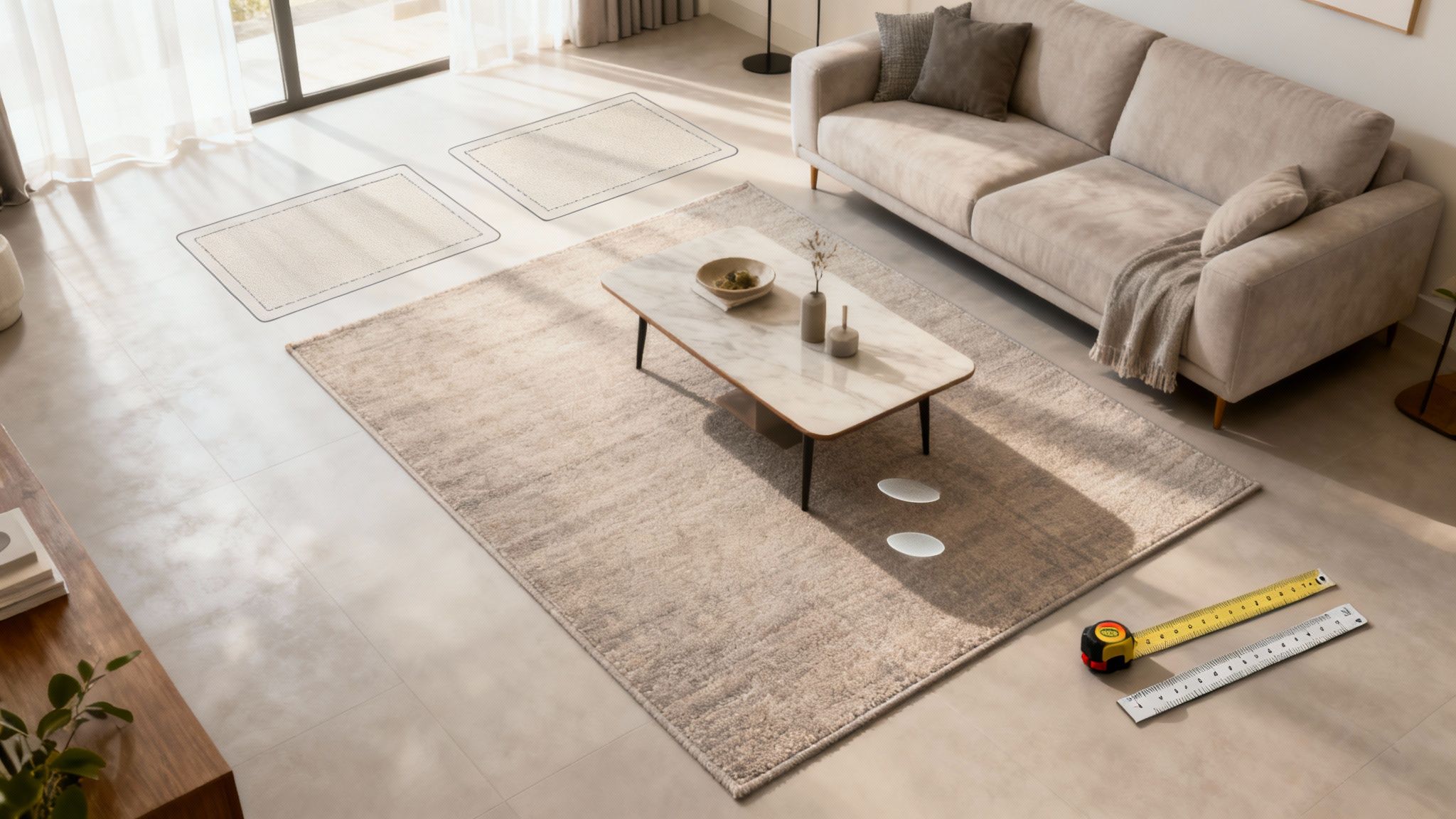
Core Placement Principles
There are three classic ways to place a rug, and each one creates a slightly different feel. Knowing these will give you the confidence to pick the right size for your layout.
To make it easier, here's a quick cheat sheet comparing the three main layout rules.
Living Room Rug Placement Rules at a Glance
The "front legs on" approach is often the sweet spot for most homes—it's practical, looks polished, and connects everything beautifully.
My go-to trick: Use painter's tape to mark out the exact dimensions of a rug you're considering. Live with it for a day or two. It’s the best way to visualise how the scale and placement will work with your furniture before you spend a penny.
Measuring for Your UK Home
It’s also worth thinking about the context of modern UK living. Household dynamics have a real impact on our interior choices. With around 8.4 million people living alone in 2023—that's nearly 30% of all households—there’s a growing need for furnishings that work in smaller, more thoughtfully designed spaces.
This trend means many of us are moving away from huge, room-filling carpets and towards more adaptable area rugs that define zones without dominating. It’s all about clever, flexible design.
Ultimately, your furniture layout dictates the perfect rug size. If you’re not sure where to start with your arrangement, our guide on how to arrange furniture in a living room is a great place to begin.
Getting the size right is all about creating balance. A good rule of thumb is to make sure your rug extends at least six to eight inches (or 15-20 cm) beyond each side of your sofa. This ensures the rug frames your main seating piece, rather than looking like an afterthought. By measuring carefully and using these placement principles, you're laying the perfect foundation for a beautifully styled living room.
Choosing Materials for Your UK Lifestyle
Once you've mapped out the perfect size, the next big decision is the material. This isn't just about looks; it's about feel, durability, and how the rug will stand up to the reality of your daily life. The material dictates everything from how it feels underfoot to how well it survives a spilled cup of tea.
Think of the fibre as the rug's DNA. It determines its softness, warmth, and resilience in a busy household. Especially in the UK, where a cosy retreat from a dreary day is non-negotiable, the choice between natural and synthetic fibres really matters.
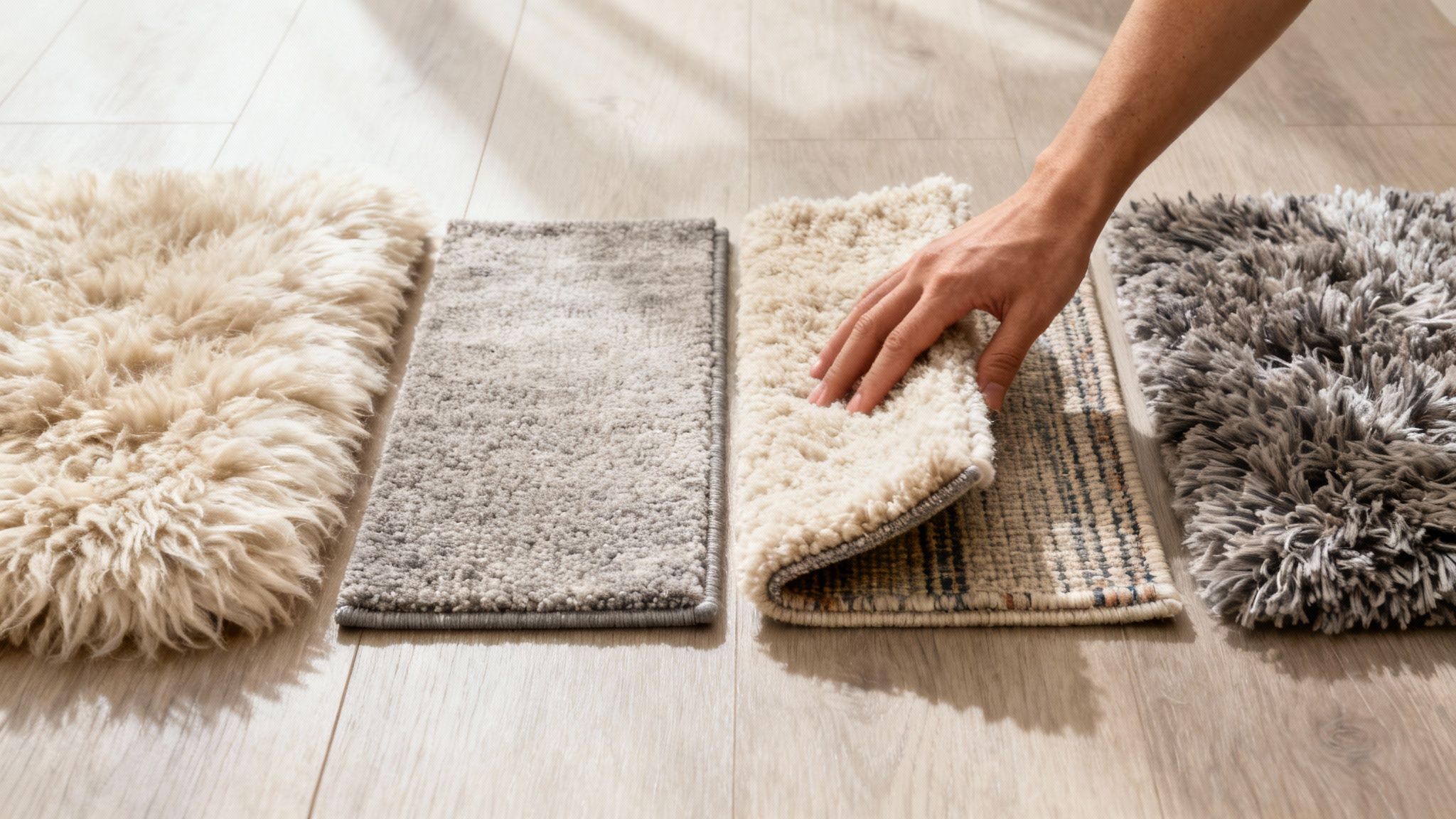
Natural Fibres: The Timeless Choice
There's a reason materials like wool, jute, and cotton have been used for centuries. They bring an organic, tactile quality to a room that synthetics often struggle to replicate.
- Wool: Honestly, it’s the undisputed champion for living rooms. Wool is incredibly durable, naturally stain-resistant (thanks to its lanolin coating), and even flame-retardant. It’s also a fantastic insulator, adding a genuine layer of warmth—a huge plus during those chilly British winters.
- Jute & Sisal: These plant-based fibres bring a lovely rustic, textural feel to a space. They are very hard-wearing, which makes them a solid bet for high-traffic spots. The trade-off? They can be a bit coarse underfoot and are more vulnerable to water stains than wool.
- Cotton: You’ll often find cotton in flatweave or dhurrie rugs. It’s soft, lightweight, and usually easier on the wallet. While it feels lovely, it just isn’t as durable as wool and stains more easily, so it’s probably better for quieter living rooms.
Wool’s enduring appeal isn't just anecdotal. In the UK, where we value that traditional, cosy feel, wool is still the top revenue-generating material, accounting for nearly 29.13% of the market share in 2024. It’s a testament to its reputation as a trusted, high-quality investment for our homes.
Synthetic Fibres: The Practical Powerhouses
Engineered for performance, synthetic fibres offer impressive durability and stain resistance, often at a friendlier price. For a bustling family home with children, pets, or frequent guests, they are often the most sensible choice.
- Polypropylene (Olefin): This is one of the most popular choices for a reason. It’s highly stain-resistant, a breeze to clean, and won’t fade in the sun. It's a real workhorse that can handle pretty much anything you throw at it.
- Nylon: Known for its exceptional resilience, nylon is brilliant for areas that see a lot of footfall. It bounces back well from furniture dents and holds its colour beautifully over time.
- Polyester: If you want luxurious softness and vibrant colours, look at polyester. It’s also naturally stain-resistant. While not quite as hard-wearing as nylon, it offers a plush feel that’s perfect for creating a really cosy atmosphere.
A great material can transform a room, but a poor choice becomes a constant frustration. Prioritise how you live first, then find a material that fits your aesthetic. For a busy family, a low-maintenance polypropylene rug will bring far more joy than a delicate silk one that causes daily stress.
What About Pile Height?
Beyond the fibre itself, you'll need to think about the pile height—that’s the density and length of the rug's fibres. It has a massive impact on both the look and practicality of your rug.
A deep pile or shag rug feels incredibly luxurious and is perfect for creating that sumptuous, kick-off-your-shoes kind of space. The catch? High piles are magnets for dirt and pet hair, making them much harder to vacuum properly.
On the other hand, a low-pile or flatweave rug has a much tighter, shorter construction. This makes it far easier to clean, which is ideal for homes with pets or allergy sufferers. Furniture also moves more easily across it, making it a better choice for under a dining table or in a busy part of the room.
Ultimately, choosing the right pile is a trade-off between lavish comfort and practical upkeep. Let your lifestyle and how much time you're willing to spend with the hoover be your guide. Of course, keeping the floor underneath in good shape is just as vital; our guide on how to clean engineered hardwood floors has some great tips to help.
Matching Rug Colour and Pattern to Your Decor
Now for the fun part. Once you've figured out the practicalities of size and material, you can get creative with colour and pattern. This is where you really get to stamp your personality on the space. A rug can be a quiet, unifying backdrop or it can be a show-stopping piece of art for your floor. The choice is yours.
Think of your rug as the room's fifth wall—it's a massive canvas that sets the tone for everything else. Your decision here will ripple out, influencing the scatter cushions you choose, the art you hang, and the overall feel of the room.
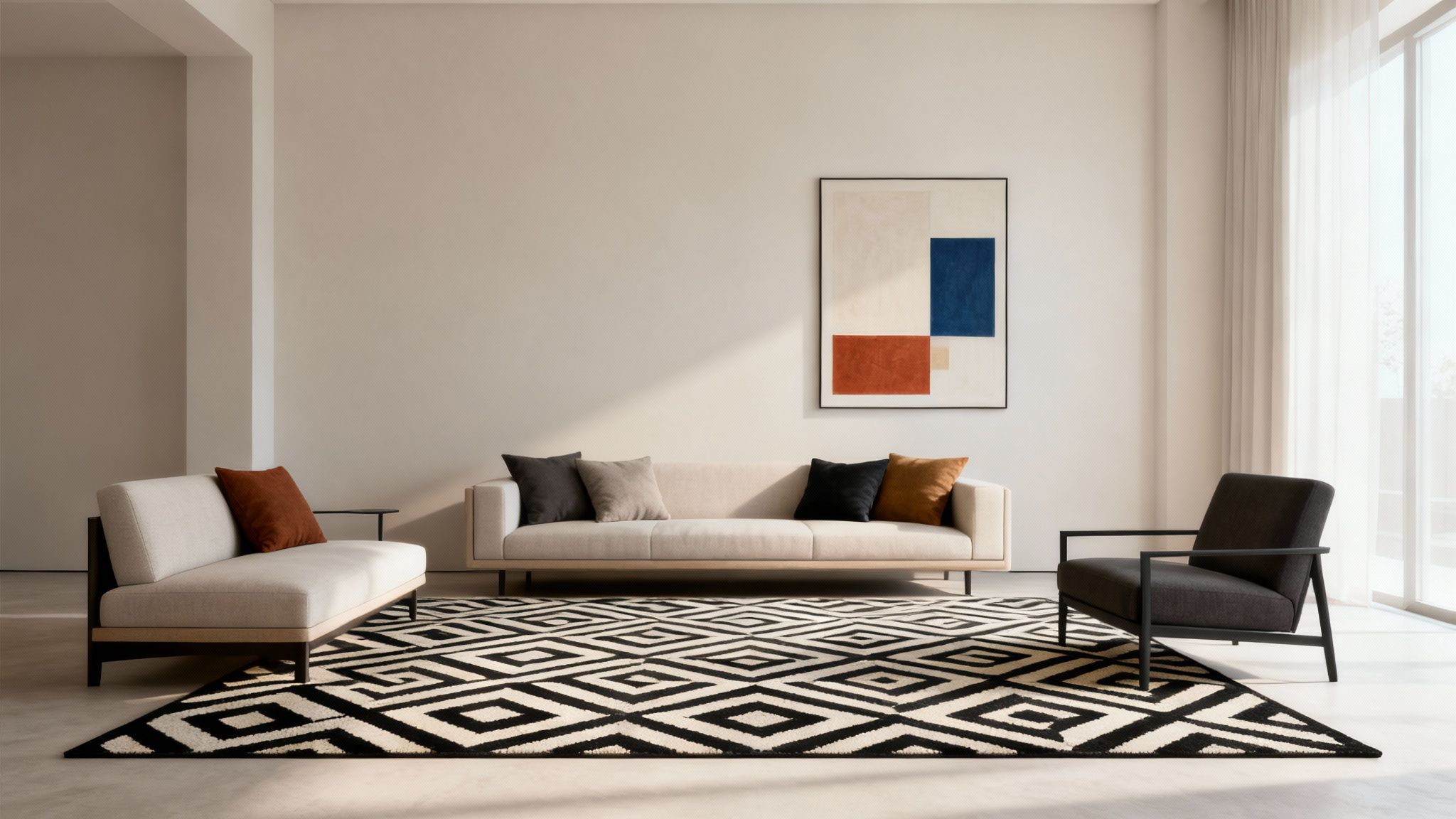
Start With Your Existing Decor
The simplest way to get a cohesive look is to let your current furnishings be your guide. Have a proper look around your living room. What are the main colours you see in your sofa, curtains, or favourite piece of artwork? A great rug will echo one or two of these existing shades, pulling the whole scheme together.
From my experience, there are two main ways to go about this:
- The Neutral Foundation: Go for a rug in a solid, neutral colour like cream, beige, or a soft grey. Natural fibres like jute or sisal also work beautifully here. This approach lets your furniture and accessories do the talking, creating a calm, textured base that won't go out of style.
- The Colourful Anchor: Find a multi-coloured or patterned rug you absolutely love and use it as your roadmap. Pull two or three accent colours from its design and sprinkle them around the room in your cushions, throws, and ornaments.
This second strategy is a lifesaver if you're feeling a bit stuck. A beautiful rug can hand you a ready-made colour scheme on a plate, taking the guesswork out of decorating and making every element feel considered.
Balancing Patterns and Solids
Bringing pattern into a room adds so much energy, but it's a delicate balancing act. The secret is to vary the scale of your prints to avoid a visual clash.
If you’ve set your heart on a bold, large-scale geometric or floral rug, that’s great! Just make sure you pair it with smaller, more subtle patterns elsewhere, like on your cushions. A big, graphic rug, for instance, looks fantastic with simple pinstripes or tiny polka dots.
On the other hand, if your sofa or armchairs already have a bold pattern, a solid-coloured or lightly textured rug is a much safer bet. It will ground the space without competing.
The goal is to let one pattern be the star of the show while the others play supporting roles. This creates layers of interest that feel rich and inviting, not chaotic.
Using Colour to Influence Mood and Space
Colour is a powerful tool. It can completely change the mood of a room and even trick the eye into thinking a space is bigger or smaller than it is.
- To Make a Room Feel Larger: Light-coloured rugs are your best friend. A rug in a pale shade like off-white, light grey, or a soft pastel reflects more light, making the room feel airy and open. This is a brilliant trick for smaller living rooms or spaces that don't get much natural light.
- To Create a Cosy, Intimate Atmosphere: Go for darker, richer tones. Deep blues, warm terracottas, or charcoal greys absorb light, which can make a large, cavernous room feel much more snug and inviting. These colours are perfect for creating that cosy 'den' feeling.
If you need a bit more inspiration, looking at some popular living room colour ideas can be a fantastic starting point for building a scheme you love.
Ultimately, the right colour is one that feels right to you. Don't be afraid to order a few samples. See how they look in your room's unique light at different times of the day—it’s the only way to be certain you've found a rug you'll be happy with for years.
Making a Practical Investment That Lasts
It’s easy to get swept up in the excitement of choosing colours and patterns, but the reality of living with your rug day-to-day is just as important. A rug isn't just a pretty accessory; it's a long-term investment in your home's comfort and style.
Thinking through the practicalities—from budget to maintenance—is the key to finding a rug you'll love for years, not just for a season. What happens when that inevitable glass of red wine takes a tumble? How will you protect both the rug and the floor underneath? Getting these details right ensures your beautiful new centrepiece is also a sensible one.
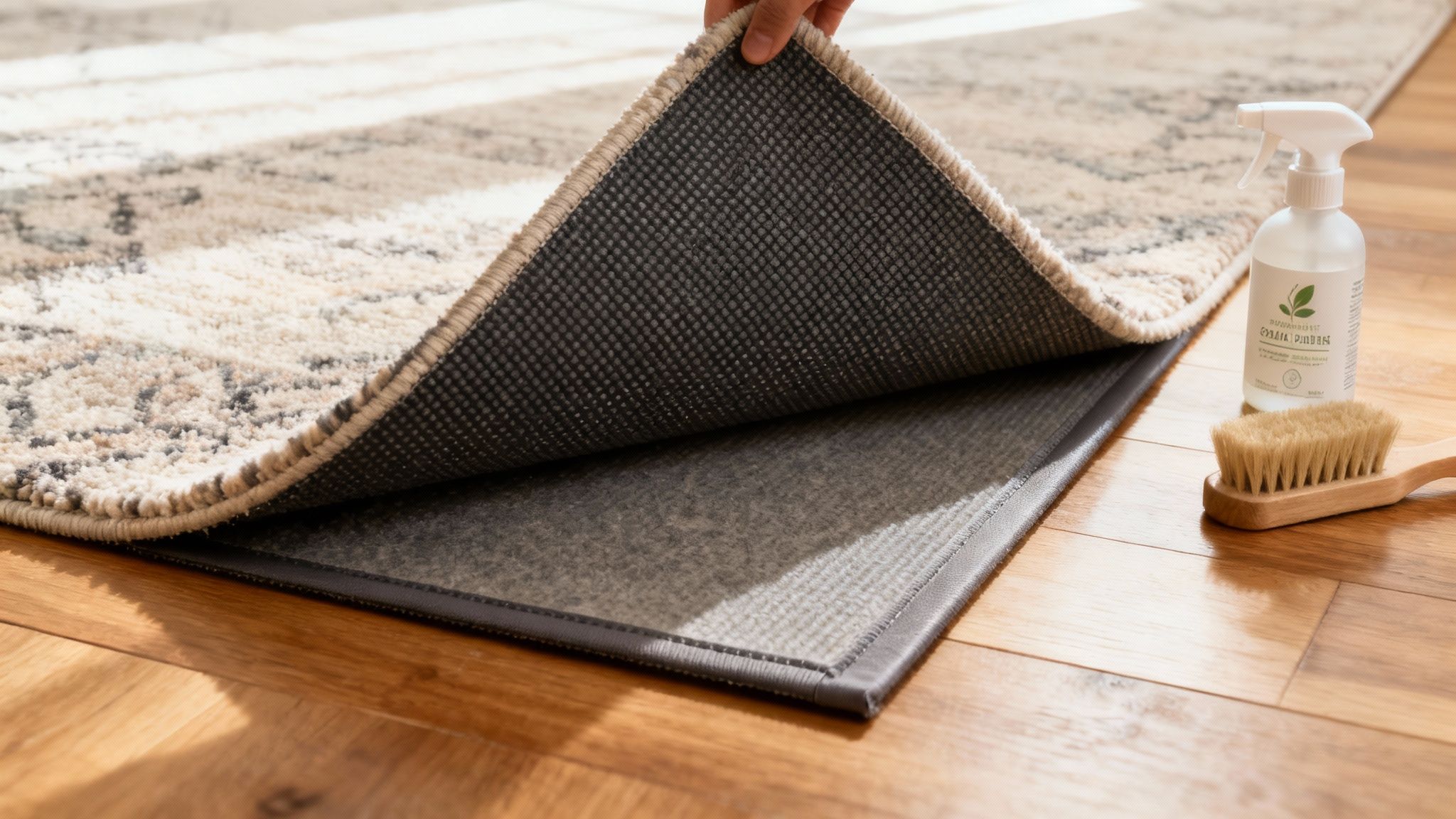
Why a Quality Rug Pad is Non-Negotiable
If you take one piece of advice from this guide, let it be this: don't skip the rug pad. It might seem like an optional extra, but a quality pad is absolutely essential for a few crucial reasons.
First off, there’s safety. A good pad grips both the floor and the rug, preventing dangerous slips, trips, and bunching – a must-have in any busy household.
It also protects your flooring. The pad acts as a buffer, stopping the rug's backing from scratching or even discolouring your beautiful hardwood or laminate over time. It promotes air circulation too, which helps prevent any moisture from getting trapped.
Finally, a rug pad genuinely extends the life of your rug. By absorbing the constant impact of footfall, it reduces wear and tear on the rug’s delicate fibres, helping it look better for much longer. Plus, it adds an extra layer of cushioning, making the whole thing feel more luxurious underfoot.
Understanding Your Budget and Setting Expectations
Rugs come in a staggering range of prices, so it’s vital to know what you can expect for your money. Setting a realistic budget from the outset will help you narrow your search and focus on options that give you the best value.
Here’s a rough guide to what different price points can get you:
- Entry-Level (£50 - £250): In this bracket, you're looking at machine-made synthetic rugs, usually polypropylene. They're a fantastic, budget-friendly choice for high-traffic spots, kids' rooms, or if you simply love to switch up your decor often.
- Mid-Range (£250 - £700): This is the sweet spot for many of us. Here you’ll find high-quality machine-made wool rugs and some lovely hand-tufted options. You're paying for better durability, more intricate designs, and a much plusher feel.
- High-End (£700+): Now you're investing in true craftsmanship. This price range is home to hand-knotted wool, silk, or unique vintage pieces. These rugs are built to last a lifetime—often becoming family heirlooms—and are really pieces of art for your floor.
Think of your rug purchase in the same way you would a sofa or a dining table. A well-made rug is a foundational piece of your home's design, and investing a little more in quality nearly always pays off in the long run.
Daily Care and Tackling Spills
The material you choose has a direct impact on how you’ll clean and maintain it. A bustling family living room with pets and kids has very different needs from a quiet, formal space used only occasionally.
Let's look at how the right material can make your life easier.
Rug Material Care and Durability Comparison
To help you decide, here's a quick comparison of the most common rug materials we see in UK homes, focusing on how they stand up to real life.
This table shows the trade-offs clearly. For a busy hallway, a durable wool or polypropylene rug is a smart bet. For a low-traffic bedroom where you want softness, a cotton or even a viscose blend could be perfect.
For example, wool is a fantastic natural material that initially repels liquids, giving you a precious window to blot a spill before it soaks in. On the other hand, synthetic fibres like polypropylene are often "solution-dyed," meaning the colour goes all the way through the fibre, which makes them incredibly resistant to staining and fading.
Making a wise purchase means looking beyond the showroom and thinking about how your choice will fit into your life. For more on this, it's worth reading our thoughts on the case for investing in forever homeware. By balancing your budget with your lifestyle and committing to proper care, you'll ensure your new living room rug remains a beautiful, practical centrepiece for years to come.
Your Rug Buying Checklist
With so much to think about, it’s easy to get overwhelmed when you finally start shopping. I've put together this simple checklist to keep you on track and help you make a decision you feel great about. It’s the perfect antidote to those impulse buys we all regret later.
Think of it as your final run-through before you commit. A quick check of these points will make sure the rug you choose is one you’ll be happy with for a long, long time.
First Things First: Size and Placement
Before you even start looking at designs, get your measurements sorted. Honestly, this is the single most important step for achieving that polished, professionally-styled look where everything just fits.
- Measure Your Space: What are the exact dimensions of your seating area? And crucially, how wide is your sofa? Remember the golden rule: your rug needs to be at least 15-20 cm wider than your sofa on each side.
- Decide on a Layout: Have you chosen a placement style? Knowing whether you're going for an 'all legs on', 'front legs on', or a 'floating' layout will dictate the exact size you need to hunt for.
- Do the Tape Test: Have you actually marked out the rug's footprint on your floor with painter's tape? It might sound silly, but living with the outline for a day or two is the best way to see how it really feels and whether it messes with the flow of the room.
Next Up: Lifestyle and Material
Okay, now it's time for a dose of reality. Thinking honestly about how you use your living room will help you choose a material that can handle your life, saving you a world of cleaning headaches down the line.
Your rug needs to work for your real life, not just for a showroom. Choosing a material that aligns with your daily activities—whether that involves children, pets, or quiet evenings—is the secret to a long-lasting and stress-free investment.
Ask yourself these questions:
- Footfall: Is your living room the main thoroughfare of the house, or is it a more formal space that sees less action?
- Who Lives Here?: Do you have kids or pets? If the answer is yes, you'll want to prioritise things like stain resistance and easy-clean materials like polypropylene or a durable, low-pile wool.
- Upkeep: How much cleaning are you genuinely willing to do? Be honest. There’s a big difference between a low-maintenance flatweave and a high-maintenance shag pile.
Finally, The Fun Part: Colour and Vibe
With the practical stuff out of the way, you can finally get creative. The colour and pattern of your rug will completely set the mood for your living room, so have a think about the atmosphere you're trying to create.
- The Goal: Is this rug meant to be a quiet, neutral foundation that lets your furniture shine, or is it the bold statement piece that steals the show?
- Colour Cues: Take a look around. What are the main colours in your sofa, artwork, or cushions? Your rug should either pick up on these tones or complement them to create a space that feels connected. For more clever ways to pull your room together, have a look at our guide to home decorating on a budget.
- Get Samples: Have you ordered samples? Please don't skip this! Seeing how the colours and textures look in your own home, with your specific lighting, is non-negotiable. A colour can look completely different in your living room than it does online.
Got Questions? Let's Talk Rugs
Even with the best plan, there are always a few lingering questions that pop up just as you’re about to commit. I get it. To make sure you feel totally confident in your choice, I’ve pulled together answers to the queries that come up time and time again.
Think of this as your final check-in, tackling those tricky little details that can make you second-guess yourself.
Can I Put a Rug on Top of Carpet?
Yes, you absolutely can! In fact, layering a rug over a wall-to-wall carpet is a fantastic designer trick. It’s a brilliant way to inject some fresh colour or pattern, add a new layer of texture, or neatly define a specific zone, like carving out a cosy seating area in a large room.
The secret to getting this right is contrast. You want to choose a rug with a noticeably different texture or pile height to the carpet below. For example, a crisp, low-pile or flatweave rug looks incredible layered over a plusher, higher-pile carpet. That difference is what makes the top rug pop.
My Pro Tip: To stop the rug from wrinkling, bunching up, or slowly migrating across the room, you must use a good non-slip rug pad. Make sure you buy one specifically designed for layering on carpet—it has a different kind of grip to keep everything locked in place.
How Do I Choose a Rug for an Open-Plan Space?
In an open-plan room, a rug is your best friend. It’s the single most powerful tool you have for creating visual structure where there are no walls. Without a rug, your furniture can feel like it’s just floating, but with one, you create a clear, defined 'zone' for relaxing that’s distinct from your dining or kitchen areas.
The golden rule here? Go big. You need a rug that’s substantial enough to anchor the entire living room setup. Ideally, you want all your main seating furniture—the sofa, the armchairs, the coffee table—to sit completely on the rug. This creates a cohesive, unified island that tells everyone, "this is the living room". It's a simple move that brings instant calm and order to a busy, multi-functional space.
What's the Best Rug for a Home with Pets and Kids?
When you've got kids or furry friends running around, your focus has to shift from pure aesthetics to pure practicality. Let’s be realistic: you need a rug that can handle high energy, the odd spill, and a whole lot of cleaning. Durability and ease of maintenance are everything.
This is where synthetic materials really shine. For family homes, they’re often the unsung heroes:
- Polypropylene: There’s a reason this is a go-to. It’s incredibly stain-resistant, tough as old boots, and you can often clean it with just a bit of mild detergent.
- Nylon: Famous for its resilience, nylon is brilliant for high-traffic areas because it bounces back so well from heavy footfall and furniture dents.
Pile height makes a huge difference, too. Low-pile or flatweave rugs are infinitely more practical than deep-pile or shag styles. They just don't trap as much dirt, crumbs, or pet hair, which means your vacuum can actually do its job properly. You get a comfortable surface without the constant cleaning headache.

